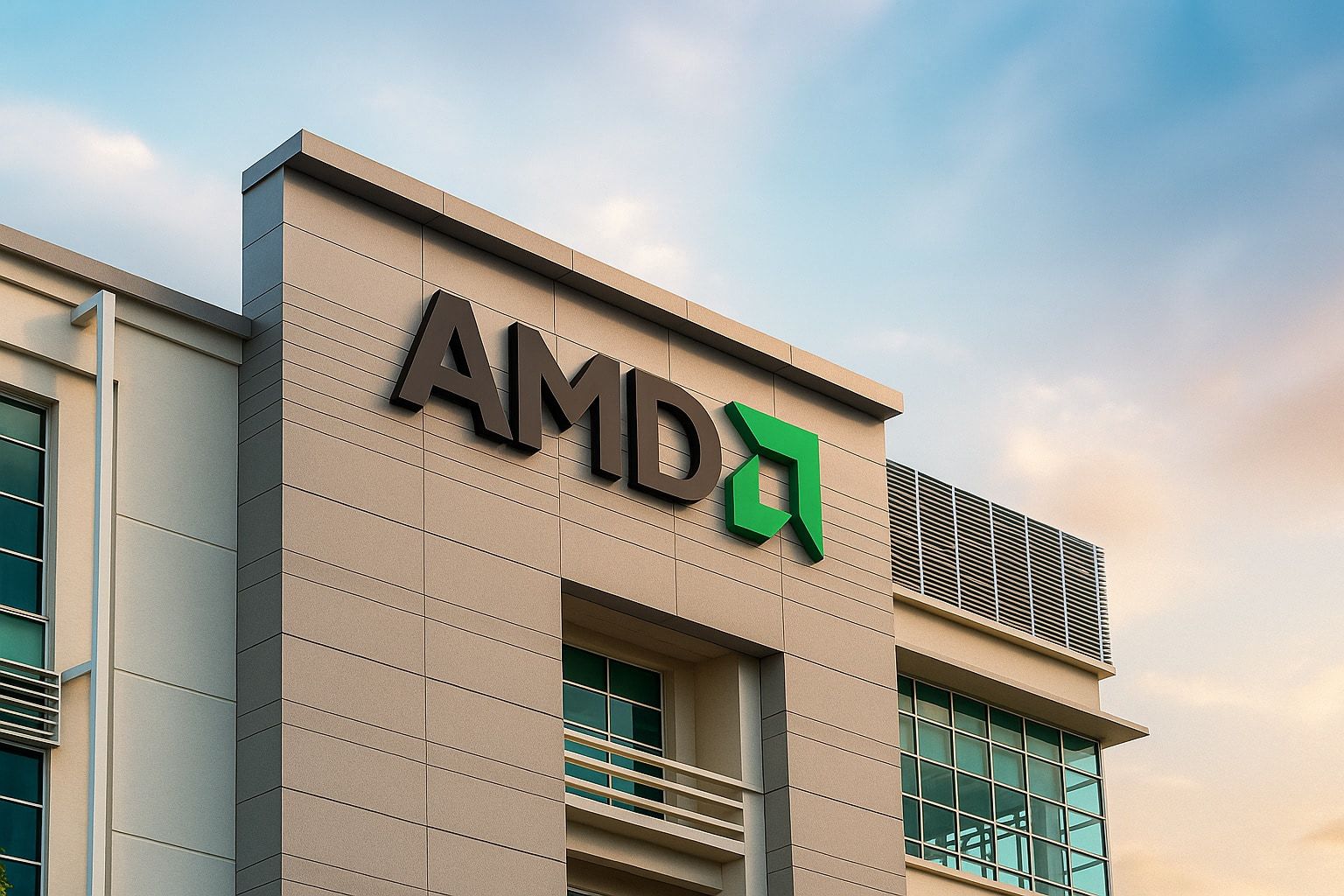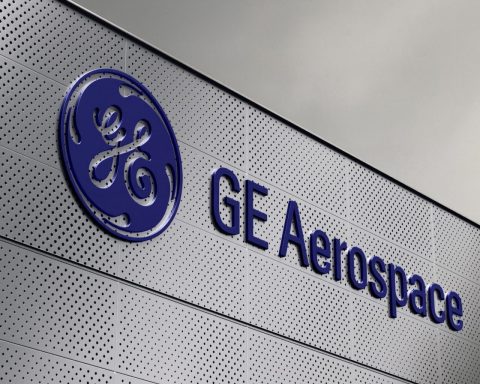- Stock Price & Momentum: Advanced Micro Devices (AMD) stock recently traded around $256 per share (as of Oct. 31, 2025), marking an ~80% year-to-date gain. It hit a new 52-week high of about $264 on Oct. 29 amid AI-fueled buying.
- AI Mega-Deals Drive Rally: Two blockbuster AI partnerships turbocharged AMD’s October surge. On Oct. 6, AMD agreed to supply OpenAI with ~6 gigawatts of its Instinct GPUs (hundreds of thousands of chips) – with OpenAI getting warrants for ~10% of AMD’s shares as part of the deal. A week later, Oracle announced plans to deploy 50,000 of AMD’s upcoming MI450 AI chips in its cloud, starting in 2026. These deals sparked a frenzy in AMD shares.
- Wall Street Upgrades: After these announcements, analysts turned bullish en masse. Multiple firms (Jefferies, HSBC, Wolfe Research, etc.) hiked 12-month price targets to ~$300. As of early November, about 60–65% of analysts rate AMD a “Buy” – up from roughly half before – though the average target (~$250) now sits only slightly above the current price.
- Crushing 2025 Peers: AMD has dramatically outperformed rival chip stocks this year. It’s up ~80% in 2025, versus roughly +30–40% for NVIDIA and essentially flat performance for Intel. (Notably, Nvidia remains the industry giant – commanding ~90% of the AI GPU market and recently becoming the first company ever to hit a $5 trillion market cap.)
- Earnings on Deck: AMD will report Q3 2025 earnings on Nov. 4. Consensus estimates call for about $8.75 billion in revenue and $1.17 EPS, which would be ~28% year-over-year growth. Investors are keen to see if the company beats forecasts and raises guidance given strong chip demand.
- High Expectations & Valuation: AMD’s stock now trades around 40× forward earnings – a rich valuation reflecting big bets on AI growth. As one strategist warned, with “extremely strong AI-driven growth” already priced in, there is “little room for error” if AMD stumbles. The company needs to deliver near-flawless execution to justify its lofty price.
Record Rally Fueled by AI Deal Frenzy
AMD’s stock went on a historic tear in October, propelled by excitement over its new AI partnerships. The rally kicked off Oct. 6 when AMD revealed its OpenAI deal – the stock skyrocketed ~34% in a single day [1], its biggest one-day jump in nearly a decade, adding about $80 billion to AMD’s market cap. Just days later, on Oct. 14, AMD got another bump (+3%) after Oracle announced plans to use AMD’s chips. These gains were especially striking because they occurred despite some broader market headwinds (e.g. interest rate and geopolitical worries) – an “AI-fueled” optimism seemed to overpower other concerns.
By mid-October, AMD traded around $240 (a new 52-week high) and was up roughly 80% year-to-date. The stock peaked near $264 on Oct. 29 amid the crescendo of AI hype. Some profit-taking followed – AMD dipped ~3.6% on Oct. 30, then ticked up ~0.5% on Oct. 31 to finish around $256. Even the broader tech sector was rallying (the Nasdaq Composite hit record territory in late October), but AMD’s rise has far outpaced the market, cementing it as one of 2025’s top-performing big-tech stocks.
AI Partnerships and Product Roadmap
The catalyst for AMD’s surge was confidence in its strategic AI partnerships – deals that not only boost future sales but also validate AMD’s technology roadmap. In early October, AMD unveiled a multi-year agreement with OpenAI to supply “hundreds of thousands” of high-end GPUs (approximately 6 GW of compute capacity) starting in late 2026. In return, OpenAI received warrants to purchase up to ~10% of AMD’s equity at just $0.01/share – effectively giving the ChatGPT creator skin in the game. AMD expects this alliance (and related demand it attracts) to generate “tens of billions” in new annual revenue, totaling over $100 billion in the next four years. AMD’s data-center chief Forrest Norrod called the deal “certainly transformative, not just for AMD, but for the dynamics of the industry”. Analysts likewise hailed it as a major “vote of confidence” in AMD’s AI capabilities – albeit one unlikely to dethrone Nvidia’s dominance overnight.
Just a week later came Oracle’s endorsement. On Oct. 14, Oracle announced it will deploy 50,000 of AMD’s forthcoming MI450 GPUs in its cloud, with the first installations in Q3 2026 and expansion in subsequent years. This gives AMD another marquee customer for its next-gen chips. Oracle’s new “AI superclusters” will be built with AMD’s “Helios” rack design – integrated systems combining EPYC CPUs and Instinct GPUs – as AMD moves to offer fully assembled AI infrastructure (similar to Nvidia’s approach). Notably, AMD had even collaborated with OpenAI to refine the MI450’s design, and OpenAI is planning a 1-gigawatt data center using those chips as early as 2024. Oracle cited the “accelerating” demand for large-scale AI capacity as a key driver of the partnership.
Crucially, these deals align with AMD’s product roadmap of positioning itself as an open-standard alternative in AI hardware. Unlike Nvidia’s proprietary AI systems (which use closed interconnects and require buying fully pre-built clusters), AMD’s philosophy is to offer more flexible, mix-and-match solutions. Its Instinct accelerators and upcoming Helios racks use industry-standard interfaces, allowing customers to integrate AMD chips into their own infrastructure. This openness – promising cost-effective, “open, secure, and scalable” AI computing – is a big reason OpenAI and Oracle chose AMD [2]. In short, AMD is leveraging these partnerships to showcase a credible #2 option in AI cloud chips. The company’s roadmap includes ramping its current MI300-series accelerators (already used in some supercomputers) and launching the MI450 in 2026 to fulfill these orders, alongside its existing CPU lines (EPYC for servers and Ryzen for PCs) that continue to advance.
Wall Street Reacts: Upbeat Targets with a Side of Caution
Investor sentiment has rapidly shifted in AMD’s favor. In the wake of the OpenAI/Oracle news, virtually every major brokerage boosted their price targets for AMD – many to levels not seen before. “Virtually every major tech analyst raised their targets” after the announcements, one market report noted. For example, HSBC upped its 12-month target to $310 (reiterating a Buy). Jefferies and Wolfe Research each moved to $300. A host of other firms – Mizuho, UBS, Piper Sandler, Baird, Evercore, etc. – also raised targets into the mid-$200s or higher. By early November, roughly 60–65% of analysts covering AMD had a “Buy” or equivalent rating (up from around 50% before the deals). Notably, Susquehanna’s highly regarded chip analyst Christopher Rolland slapped a $300 target on AMD on Oct. 31, citing strengthening prospects in server and AI sales. In short, Wall Street now largely views AMD as a prime beneficiary of the AI wave in 2024–26.
However, not everyone is jumping on the bandwagon. A few heavyweights remain neutral or cautious.Goldman Sachs, for instance, kept its rating at Neutral even after the OpenAI deal – maintaining a $210 target. Goldman’s analysts acknowledged the OpenAI pact was “a substantial positive for AMD,” but they flagged “potential funding risks tied to the business and likely high customer concentration” in AMD’s AI segment as ongoing concerns. Similarly, Morgan Stanley raised its target from $168 up to $246 in response to AMD’s AI wins, yet it maintained an “Equal-Weight” (hold) stance – essentially a vote of confidence in the long-term revenue, but caution on valuation. Citi is also said to be on the sidelines with a target in the low-$200s. These more skeptical analysts argue that AMD’s stock price already reflects most of the good news. Indeed, despite the flurry of upgrades, the average 1-year price target is only ~$250, barely above the current trade level. As a JPMorgan strategist summed up, investors have baked in “extremely strong AI-driven growth,” leaving “little room for error” if AMD’s execution disappoints. In other words, the bar is set very high.
Technical Analysis – Momentum Meets “Overbought” Signals
From a technical chart perspective, AMD’s momentum has been powerful – but perhaps a bit too powerful in the short run. The stock’s price has blown past key support levels: at ~$256, AMD is trading far above its moving averages, which is bullish. (For instance, the stock sits well above even its 50-day average around $191, and miles above the 200-day near $139.) This kind of gap indicates a strong uptrend – AMD has more than tripled from its 52-week low of around $76, and all short- and long-term trend indicators point upward.
However, the parabolic rise has also pushed some indicators into caution territory. Notably, AMD’s Relative Strength Index (RSI) – a momentum oscillator – recently spiked above 70, a level typically seen as “overbought.” (TipRanks data showed a 14-day RSI of about 74, which triggered a short-term sell signal.) Other oscillators like stochastic also hit extreme highs. These readings suggest that buyers may have overshot in the near term, and the stock could be due for consolidation or a pullback. In fact, after hitting ~$264, AMD did stall and dip modestly before finding support. Traders will be watching whether AMD can hold key support levels (recently in the mid-$240s) on any further dips. Volatility has picked up as well – daily swings have widened with the influx of speculative trading around AI news. Bottom line: The technical trend is overwhelmingly positive (all major moving averages are sloping up, a classic bull sign), but short-term traders should be cautious about chasing the stock at overbought levels. A period of sideways trading or mild correction would be normal after such a steep climb, potentially providing better entry points for those who missed the initial run-up.
Fundamental Analysis – Strong Growth, Rich Valuation
On the fundamental side, AMD’s business is growing at an impressive clip, though profitability has seen some noise from one-time charges. In Q2 2025, AMD reported revenue of $7.7 billion, up 32% year-on-year, topping analyst expectations. This growth was driven by record sales in its PC processor and data center chip divisions, thanks to strong demand for Ryzen CPUs and EPYC server processors. However, Q2 earnings per share came in below forecasts at $0.48, due to a sizeable $800 million inventory write-down the company took on unsold MI300 AI chips amid new U.S. export restrictions. (Those charges – related to the government’s ban on certain high-end GPU sales to China – were one-time; excluding that, AMD’s gross margin would have been around 54% rather than the reported 43%.) Despite that hit, AMD remained solidly profitable and cash-generative – it produced over $1 billion in free cash flow in Q2 and even repurchased $478 million of its own stock during the quarter, a sign of management’s confidence in future cash flows. The company ended Q2 with a healthy $5.9 billion in cash on hand and relatively low debt, giving it flexibility to invest in new products and capacity.
Looking ahead, AMD’s growth trajectory is expected to accelerate in the second half of 2025. For Q3 2025, which will be reported on Nov. 4, AMD itself guided for about $8.7 billion in revenue at the midpoint. That represents roughly +13% sequential and +28% year-over-year growth – an unusually strong jump, reflecting improving PC demand and ramping sales of AI accelerators (MI300 series). Importantly, AMD said it expects gross margins to recover to around 54% in Q3 now that the earlier inventory glut has been addressed. If AMD hits that forecast, it means the company’s underlying profitability (excluding one-off charges) remains solid even as it invests heavily in new AI chips. For the full year 2025, Wall Street consensus calls for ~$33 billion in revenue (AMD’s own guidance is in the same ballpark). That would be >20% annual growth and a fresh record high for AMD’s top line. (By comparison, Nvidia – supercharged by AI demand – is expected to post over $200 billion revenue in its current fiscal year, underscoring the gap but also the room for AMD to expand.) AMD’s core markets are generally healthy: the company has been steadily gaining CPU market share from Intel in both laptops and servers, and its semi-custom chip business (like console GPUs) provides additional steady revenue. Now, with the new AI deals, there’s an anticipation of a significant uptick in data center GPU sales in late 2025 and into 2026. All of this paints a picture of a company firing on multiple cylinders – PCs, consoles, servers, and AI – heading into 2026.
That said, AMD’s valuation has ramped up in tandem with its growth prospects. At ~$256/share, AMD is priced around 40× forward earnings (and an even higher multiple of trailing earnings, due to the recent inventory charge impact). This is a premium valuation by any measure – investors are effectively paying now for earnings AMD is expected to deliver a few years down the line. Why are they willing to do so? Because Street analysts forecast AMD’s earnings will increase dramatically in coming years. Estimates call for roughly 39% compound annual EPS growth over the next 3–5 years, one of the fastest projected growth rates among large-cap tech stocks. If AMD indeed grows its bottom line ~40% annually, today’s 40× P/E would shrink quickly, making the stock much more reasonable on a forward basis. The big question is whether AMD can fulfill those growth expectations. The company’s fortunes are now heavily tied to AI/datacenter traction: investors expect the OpenAI and Oracle deals (and others that might follow) to translate into a surge of high-margin revenue from 2026 onward. Additionally, AMD needs its core CPU and GPU businesses to keep executing – taking further market share from Intel, and fending off Nvidia and others in graphics – to hit those ambitious earnings targets. Any stumble (a product delay, a loss of a design win, a macro slowdown in tech spending, etc.) could lead to a significant reset in the stock’s valuation. As mentioned, much of the “AI hype” is already baked in – one strategist cautioned that AMD now has “little room for error” given how much optimism is in the price. In summary, AMD’s fundamentals are strong and improving, but the stock’s price implies near-flawless execution and sustained high growth. Hitting the upcoming numbers (and raising guidance) will be crucial to maintain investor confidence.
AMD vs. Competitors: The Race with Nvidia and Intel
AMD’s bold moves come as it jockeys against industry giants in a rapidly evolving market. In the realm of AI hardware, Nvidia is the 800-pound gorilla – and remains well ahead by most metrics. In late October, Nvidia’s valuation briefly hit an astonishing $5 trillion (yes, trillion) after a year of frenzied stock gains. Nvidia stock has risen roughly 12-fold since the launch of ChatGPT kicked off the current AI boom, as the company utterly dominates the supply of AI accelerator chips. By some estimates, 90–95% of data-center AI workloads run on Nvidia GPUs. Nvidia’s revenues reflect that dominance: it’s on track for over $200 billion in annual sales next year, dwarfing AMD’s ~$33 billion expected in 2025. As one analyst quipped about the AI chip landscape, “it remains [Nvidia’s] world, with everybody else paying rent.”
That said, AMD is now firmly the second source for AI chips, something that was not guaranteed even a year ago. The OpenAI and Oracle deals served as high-profile endorsements that AMD can compete with Nvidia on cutting-edge accelerators, at least for certain customers. AMD’s strategy to crack Nvidia’s lead is to be the “open” alternative: instead of a closed ecosystem (like Nvidia’s CUDA software and proprietary interconnects), AMD offers chips that use open standards and can plug into existing systems with more flexibility. Its new Instinct MI300/MI350 GPUs and “Helios” rack solution are pitched as a cost-effective, modular way to build AI infrastructure – a contrast to Nvidia’s full-stack DGX supercomputers. This resonates with big cloud players who want to avoid vendor lock-in. “AMD has really trailed Nvidia for quite some time. So I think [the OpenAI deal] helps validate their technology,” said Leah Bennett of Concurrent Asset Management. Still, Nvidia’s first-mover advantage (and software ecosystem) is massive; even with these wins, AMD likely has only a small single-digit percentage of the AI accelerator market. In short, AMD is making inroads – positioning itself as #2 in the “AI GPU” space – but Nvidia remains the overwhelmingly dominant force that AMD (and others) must continue to chase.
Meanwhile, Intel, the traditional x86 CPU rival to AMD, is trying not to get left behind in the AI era. 2025 has seen a bit of a turnaround effort from Intel on multiple fronts. The U.S. government took a ~$9 billion stake in Intel to support domestic chip manufacturing (part of the CHIPS Act initiatives). And in a surprise move, Nvidia itself agreed to invest $5 billion in Intel and partner on certain foundry and networking technologies. That news in September sent Intel’s stock soaring 23% in one day – its biggest single-day jump since 1987 – and overall Intel shares are up about 50% this year (though much of that came from that one spike). Intel is now developing its own data-center GPUs, code-named “Crescent Island,” aiming to become a viable third player in AI accelerators by late 2024–2025. The company’s strategy seems to be to leverage its still-formidable manufacturing and R&D resources, plus government support, to eventually offer an AI platform that can compete. However, Intel has a lot of ground to make up. Its market cap remains around $130–150 billion (only about half of AMD’s, and a tiny fraction of Nvidia’s). And unlike AMD – which is already selling AI chips and winning marquee deals – Intel is largely playing catch-up; its current AI GPU offerings are limited, and its first major products are likely a year or more away from mass deployment. Most analysts view Intel’s AI foray with skepticism in the short term, adopting a “wait and see” attitude. If Intel executes, it could expand the competitive landscape long-term (and potentially win business from cloud providers that want yet another supplier). But for now, Intel doesn’t pose an immediate threat to AMD’s momentum in the high-end CPU/GPU arena. In fact, AMD continues to encroach on Intel’s core CPU business – recent data shows AMD gaining share in server processors, a trend expected to continue as its EPYC chips benefit from strong cloud demand.
In summary, AMD finds itself in a unique position: it’s simultaneously the challenger to an overwhelmingly dominant competitor (Nvidia in AI), and the incumbent rival being challenged by a once-dominant player seeking a comeback (Intel). The next 1–2 years will be pivotal in determining how much of Nvidia’s turf AMD can reasonably capture, and whether Intel can insert itself as a serious third competitor. For now, AMD’s market position looks strong – arguably stronger than it’s ever been – but the company will need to keep innovating and executing to hold that position in this three-way race.
Outlook – High Stakes Into Year-End and Beyond
With AMD’s stock at record highs and the AI narrative in full swing, the focus now shifts to execution: Can AMD deliver on the sky-high expectations it has set? The next few weeks will be critical. AMD’s Q3 earnings report on Nov. 4 is a major near-term catalyst. Investors will parse the results and (perhaps more importantly) management’s guidance for Q4 and commentary on 2026. There is cautious optimism that AMD will at least meet, if not beat, the Q3 consensus ($8.7B rev, $1.17 EPS) – the company has a decent track record (7 of the last 8 quarters beating revenue estimates). Top analysts like Rosenblatt’s Kevin Cassidy are expecting a “modest beat-and-raise” quarter, citing robust PC and server chip demand as tailwinds. If AMD indeed reports strong numbers and sounds upbeat about the pipeline, it could reinforce the bull case and potentially push shares higher. On the call, investors will be listening for updates on key themes: progress fulfilling the OpenAI/Oracle orders, any new AI customer wins, the supply ramp for MI300/MI350 chips, trends in the PC market, and the status of export license issues (e.g. whether U.S. chip restrictions are under control). Even subtle comments from CEO Lisa Su or CFO Jean Hu about 2026 prospects or gross margin trajectory could sway the stock, given how far forward the market is looking.
Hot on the heels of earnings, AMD will host its Analyst Day on Nov. 11, 2025 – another closely watched event. Analyst Day is where AMD’s leadership will likely lay out the strategic roadmap for the next 1–2 years, possibly including more detail on the MI450 GPUs (the ones slated for OpenAI/Oracle), next-generation Ryzen and EPYC CPUs (built on newer architectures), and its software strategy like the ROCm AI software stack. The company might also discuss capacity investments, given the huge orders on the horizon (investors will want to know that AMD can produce enough chips to meet demand). Any new product announcements or demos could be catalysts – for example, if AMD reveals a breakthrough AI chip or an acceleration in timelines, that would be taken very positively. Conversely, if little new information emerges, it could disappoint those looking for the next “wow” moment. In short, the first half of November represents an inflection point: AMD has to back up the hype with substance. As one report put it, these events will be the “next inflection points for AMD’s 2025 story.”
Beyond these immediate events, the long-term narrative for AMD is tied to the trajectory of the AI boom and AMD’s role in it. CEO Lisa Su has been adamant that we are entering a profound new cycle: “AI is the most transformative technology of the last 50 years,” she said recently, emphasizing that we’re only beginning to see its impact [3]. She cautions that one must “look at what the power of this technology can do for the world” [4] – a statement underscoring AMD’s conviction (and investment) in AI as a growth driver. This bullish view is echoed by many in the market: if AI adoption continues to explode, the demand for advanced chips (GPUs, adaptive SoCs, etc.) will likely outstrip supply for years, creating a multi-year tailwind for companies like AMD. On top of that, AMD’s other businesses (PC, gaming, data center CPUs) stand to benefit if the broader economy and tech spending remain strong. Bulls argue that under such a scenario – secular AI growth plus solid execution – AMD’s stock could continue climbing. Some optimists are already whispering about the stock reaching $300+ in the coming months, especially if AMD secures additional AI wins (for instance, landing another hyperscaler client or seeing strong MI300 sales to existing cloud customers).
However, risks abound and investors should not get complacent. The “hype premium” in AMD’s valuation means any hiccup could cause a sharp pullback. If, for example, the Q3 earnings or Q4 guidance disappoint in any way – say data center GPU sales don’t ramp as fast as hoped, or PC demand softens again – the stock could see a rapid correction. Likewise, macro factors (interest rates, geopolitical issues, etc.) or a rotation out of high-valuation tech could impact AMD. Competition will also heat up: Nvidia is not standing still (its next-gen products could widen the gap again), and Intel will throw considerable weight into reasserting itself in 2026–27. Supply constraints could emerge as well; AMD is fabless and relies on TSMC to manufacture its chips, so any capacity bottlenecks or export limitations could constrain its ability to capitalize on demand. In essence, AMD is now priced for perfection, and while its future looks bright, the execution risks are real.
For now, investors seem willing to bet that AMD’s AI-fueled ride is just beginning. The stock’s remarkable 2025 rally has been a vote of confidence that CEO Lisa Su’s strategy – betting big on high-performance silicon for the AI era – will pay off. The coming days (earnings and Analyst Day) will give us the first real data points post-deals to judge how well AMD can convert hype into financial results. If AMD delivers strong numbers and upbeat forecasts, it could reinforce the bull case and keep the stock levitated near its highs (or even propel it higher). But if results or commentary underwhelm, investors may quickly reassess how much of the AI dream is already in the price. Keep an eye on those events; as AMD’s 2025 chapter unfolds, we’ll soon find out if the stock’s record run has more room to run – or if this is where reality checks in on the AI hype cycle.
Sources: Recent market news and data from AMD’s earnings previews and investor releases, TS2.tech analysis of AMD’s AI deals and stock surge, Reuters coverage of the OpenAI and Oracle partnerships, analyst commentary via TipRanks/Investing.com, and Bloomberg/Reuters reports on broader AI market trends. All information is current as of Nov. 2, 2025.








